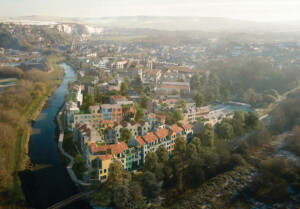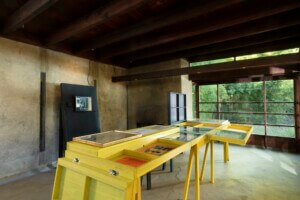In 2014, Sean Griffiths exhibited My Dreams of Levitation at RoomArtSpace in London. His first piece since the closure of architecture practice FAT, the installation inhabited a series of first floor rooms of a Georgian house and saw wooden copies of the existing skirting boards and architraves displaced and hanging from the ceiling. My Dreams of Levitation forced visitors to duck and weave, taking unexpected journeys through the otherwise empty space. It also reflected moving property boundaries in the capital. Ultimately, though, the exhibition was Griffiths first foray into exploring the minimum requirement to make architecture.
This journey, perhaps, might be what Tim Ingold defines as a “line.” To the British anthropologist, life is not lived in places, but along paths.
“By habitation I do not mean taking one’s place in a world that has been prepared in advance for the populations that arrive to reside there,” he argues in his book, Lines: a Brief History. “The inhabitant is rather one who participates from within in the very process of the world’s continual coming into being and who, in laying a trail of life, contributes to its weave and texture.”
Furthermore, Ingold eschews the “pervasive metaphor” of building blocks—for life, thought, and the universe—instead adopting notions of weaving, threading, twisting and knotting, a theory Gottfried Semper was also on board with. And like Semper (who drew from Marc-Antoine Laugier), Griffiths too has his eyes set on architectural reduction.
In his latest exhibit, Griffiths continues this exploration. Entering Tontine Street in Southeast England by walking from Folkestone Central railway station, it’s easy to miss Levitation I, a 3-D cube painted on the façade of HOP Projects’ gallery. The narrow pavement means you really have to crane your neck to see the distorted cube, which is best viewed from an island in the middle of a junction not meant for pedestrians. Other than that, you can see it across the street, but this results in an arduous journey to get back to the gallery itself.
Colored three shades of green to indicate light and shadow, Levitation I conflicts with the building’s rudimentary window arrangement. It serves as a preamble for the even more incongruous Levitation II.
Deliberately disorientating, Levitation II inhabits the gallery space inside. The area in spatial terms, if you ignore the art, is by all means weird. This is the result of various forms of usage before Tomás Poblete and Nina Shen-Poblete of HOP Projects took over in July this year. It can only truly be understood in plan and section, but visitors do not have access to these drawings and so Griffiths’ laconic interventions continue to disrupt visitors’ perceptions.
On the floor is a grid made from pebbles from the nearby beach. The grid has been rotated so not to align with the room’s geometry, failing to run parallel with any walls and sending viewers equally off-kilter. The pebbles are loose and could easily be kicked, but the overriding instinct is to walk with trepidation and avoid disrupting the order, which is ironic given the spatial purpose. Evidently, others have thought the same. Despite the gallery being open and apparently unstaffed (I later found out they reside above) the pebbled grid appears untouched.
More lines can be found on the walls and ceiling, this time found in the form of colored masking tape. These, though, are not as connected. Inside the gallery they vary in thickness and in length, spanning the white surface in a warped perspective like the experience of looking up at Levitation I. As you move around inside, some lines match up and the shapes can be read as more traditional, orthogonal forms. Some perspectives require you to step outside the gallery altogether for this view to come into alignment. It can be a fun game to shuffle left and right to make this happen as you stand there with a camera, but expect some odd looks.
The game of illusory perspective has, admittedly, been done before. But in the context of the façade, the pebbles on the floor, and the bizarre gallery space itself, its effect is amplified. The real trick, however, is at a much finer scale. Up close, so close your nose almost touches the wall, the masking-taped lines are revealed to be curved. Again, this behavior may result in glances cast in your direction.
Does all of this manifest as an inhabitable drawing? Griffiths hopes so; he’s certainly on the right path.
Levitation I + II
HOP Projects
73 Tontine Street, Folkestone
Through December 2










